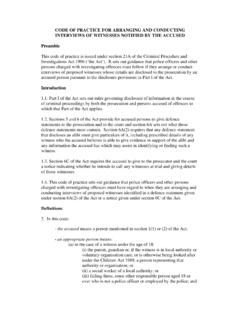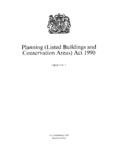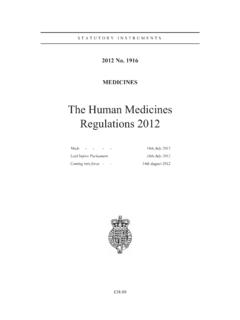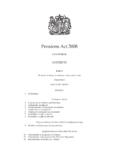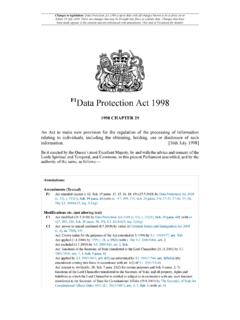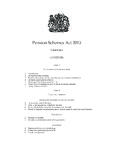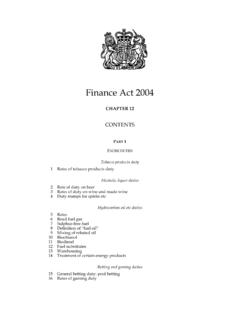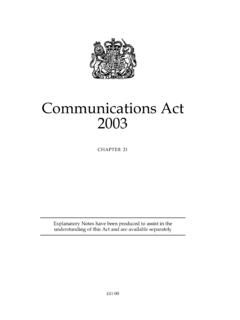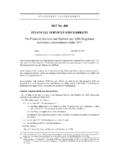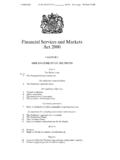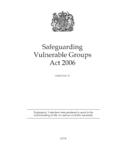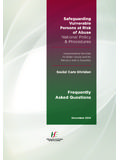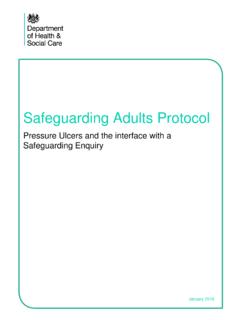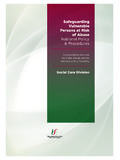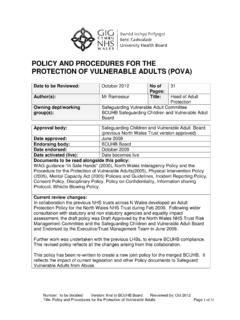Transcription of SAFEGUARDING VULNERABLE GROUPS ACT 2006
1 These notes refer to the SAFEGUARDING VULNERABLE GROUPS Act 2006 ( )which received Royal Assent on 8 November 20061 SAFEGUARDING VULNERABLE GROUPS ACT 2006 EXPLANATORY explanatory notes relate to the SAFEGUARDING VULNERABLE GROUPS Act whichreceived Royal Assent on 8th November 2006. They have been prepared by theDepartment for Education and Skills in order to assist the reader in understanding theAct. They do not form part of the Act and have not been endorsed by notes need to be read in conjunction with the Act. They are not, and are not meantto be, a comprehensive description of the Act. So where a section or part of a sectiondoes not seem to require any explanation or comment, none is AND current system for vetting people who wish to work with children or vulnerableadults operates through employers obtaining criminal record certificates issued by theCriminal Records Bureau ( CRB disclosures ) for new job applicants.
2 CRB disclosuresgive employers information about an individual s criminal records history, whichinforms their assessments about the individual s suitability to work with children orvulnerable are also three separate lists of persons who are barred from working withchildren or, as the case may be, VULNERABLE adults. These lists operate under differentlegislation and with different criteria and procedures: List 99 (a list of those in respectof whom directions under section 142 of the Education Act 2002 have been made), theProtection of Children Act (POCA) List (maintained under the Protection of ChildrenAct 1999) and the Protection of VULNERABLE Adults (POVA) List (maintained under Part7 of the Care Standards Act 2000). Disqualification orders made by a court (under Part2 of the Criminal Justice and Court Services Act 2000) also bar individuals fromworking with Bichard Inquiry Report (June 2004), available , identified systemic failures in current vetting andbarring systems.
3 These included the following factors:xinconsistent decisions were being made by employers on the basis of CRBdisclosure informationxCRB disclosure information is only certain to be accurate on the day of issuexthere are inconsistencies between List 99, the POCA list and POVA listxthe current barring system is reactive to harmful behaviour rather thanpreventativexthere are inconsistencies between police authorities in the disclosure of Act provides the legislative framework for a new vetting and barring scheme forpeople who work with children and VULNERABLE adults. A public consultation for the newscheme,Making SAFEGUARDING Everybody s Business: A Post-Bichard Vetting SchemeThese notes refer to the SAFEGUARDING VULNERABLE GROUPS Act 2006 ( )which received Royal Assent on 8 November 20062(Ref: 1485-2005 DOC-EN), ran from 5 April 5 July 2005.
4 This consultation paper anda summary of the responses to it can be found at purpose of the new scheme is to minimise the risk of harm posed to children andvulnerable adults by those that might seek to harm them through their work (paid orunpaid) (whether they fall into the category of regulated activity , see paragraphs 41to 47, or controlled activity , see paragraphs 98 to 103; see also the glossary in AnnexA for further explanation). It seeks to do this by barring unsuitable individuals not juston the basis of referrals but also at the earliest possible opportunity as part of acentralised vetting process that all those working closely with children and/orvulnerable adults will need to go Act provides that:xThere will be two barred lists one for those who are barred from engaging inregulated activity with children (the children s barred list ), and one for thosewho are barred from engaging in regulated activity with VULNERABLE adults (the adults barred list ).
5 XThere will be an Independent Barring Board ( IBB ). The IBB will maintain thechildren s barred list and adults barred list and will make decisions aboutwhether an individual should be included in one or both barred will be a right of appeal to the Care Standards Tribunal, with thepermission of the Tribunal, against inclusion in a barred list on a point of law oron a finding of fact made by the will be four routes to inclusion on one or both of the barred lists (seediagram at Annex D).xAutomatic inclusion on one or both of the barred lists as a result of receiving acaution or conviction for specified offences, or other criteria which may bespecified (such as orders, foreign orders or directions, and inclusion on a foreignbarred list). There will be no right for the individual to make representations nor aright of appeal in these inclusion on one or both of the barred lists as a result of receiving acaution or conviction for certain other specified offences or as a result of havingmet some certain other specified criteria.
6 There will be a right to makerepresentations and a right of appeal following behaviour (the term relevant conduct is used in the Act) that leads toconsideration for inclusion on one or both of the barred lists. This includes, forexample, conduct which harms a child in the case of the children s barred list, orconduct which harms a VULNERABLE adult in the case of the adults barred list, orconduct involving child pornography for both of harm: where evidence suggests that an individual may present a risk ofharm to children or VULNERABLE adults, this will lead to consideration for inclusionon the appropriate individual who is included in the children s barred list must not engage inregulated activity in relation to children. An individual who is included in theadults barred list must not engage in regulated activity in relation to vulnerableThese notes refer to the SAFEGUARDING VULNERABLE GROUPS Act 2006 ( )which received Royal Assent on 8 November , regulated activity will cover a range of specified activities that providean opportunity for close contact with children or VULNERABLE adults, other activitiesin key settings such as schools and care homes which provide an opportunity forcontact and key positions of responsibility such as the Children s Commissionerand the Director of Adult Social are a series of criminal offences to:a.
7 Prevent barred individuals from engaging in regulated activity in relation tochildren or VULNERABLE adultsb. ensure that people permitted to engage in regulated activity in relation tochildren or VULNERABLE adults with the permission of a regulated activityprovider are subject to monitoringc. ensure that relevant employers check an individual s status in the schemebefore permitting an individual to engage in regulated activity in relation tochildren or VULNERABLE adultsxTo become subject to monitoring individuals will need to make an application tothe Secretary of State, in the guise of the Criminal Records Bureau (CRB).xThe Act also confers power on the Secretary of State to make regulations aboutcontrolled activity. This covers certain activity other than regulated is no current intention to prevent a barred individual from engaging incontrolled activity.
8 But in part the regulations will be used so as to requireemployers (and others with responsibility for managing controlled activity) to putin place appropriate safeguards to manage the risks posed by barred , controlled activity covers support work in general health settings, furthereducation settings and adult social care settings. It also covers work which givesa person the opportunity for access to sensitive records about children andvulnerable adults, including education and social services will the new scheme work? paragraphs provide a very brief overview of how the new scheme will work andwill help to put into context the overview of the legislation given above. They need tobe read in conjunction with the diagram at annex Those who are closely working, or applying to work, with children or VULNERABLE adultswill be required to make an application to the Secretary of State to be subject tomonitoring (see the glossary at Annex A).
9 This will cover everyone engaging in whatthe Act refers to as regulated activity with the permission of a regulated activityprovider . (The intention is that employers engaging individuals in controlled activity will also in most cases need to ensure that they are subject to monitoring, although thisrequirement will be placed on employers through regulations). The Act allows for thephasing in of applications from existing members of the The Secretary of State, using the Criminal Records Bureau (CRB), will then search thePolice National Computer for cautions and convictions and make enquiries of localpolice forces to obtain other relevant Where the Secretary of State s enquiries reveal that a person satisfies one of the criteriaThese notes refer to the SAFEGUARDING VULNERABLE GROUPS Act 2006 ( )which received Royal Assent on 8 November 20064that lead to automatic inclusion in a barred list, he will refer the matter to the IBB sothat the person can be included in the relevant barred list.
10 The Secretary of State willalso pass details of relevant cautions and convictions together with all informationreceived from local police forces to the IBB, which the IBB can then consider inrelation to inclusion in a barred list. Where a person is included in a barred list, heceases to be subject to monitoring (if he was previously) and is not able to engage inregulated activity. Except in the most serious cases, individuals will have theopportunity to make representations about why they should not be barred on the basisof this At appropriate intervals, the Secretary of State must repeat the searches and enquiriesreferred to above. If new information comes to light about a person who is subject tomonitoring, the Secretary of State will give the information to the IBB as outlinedabove.
